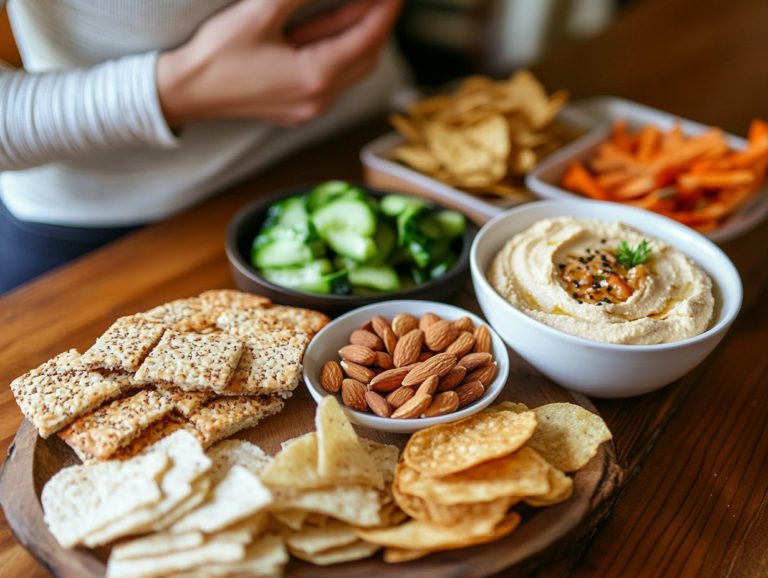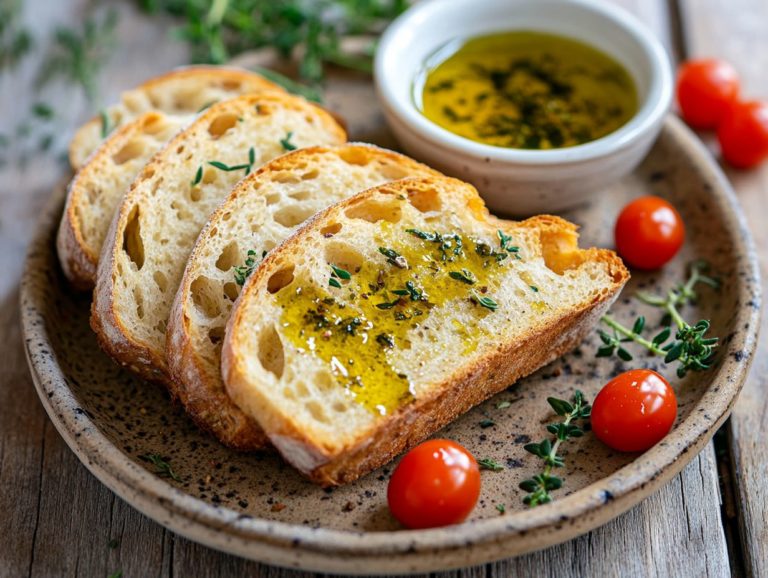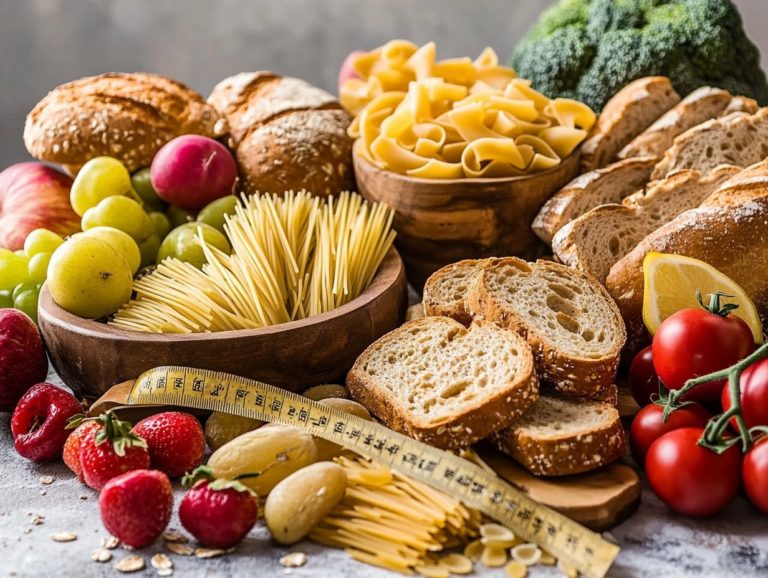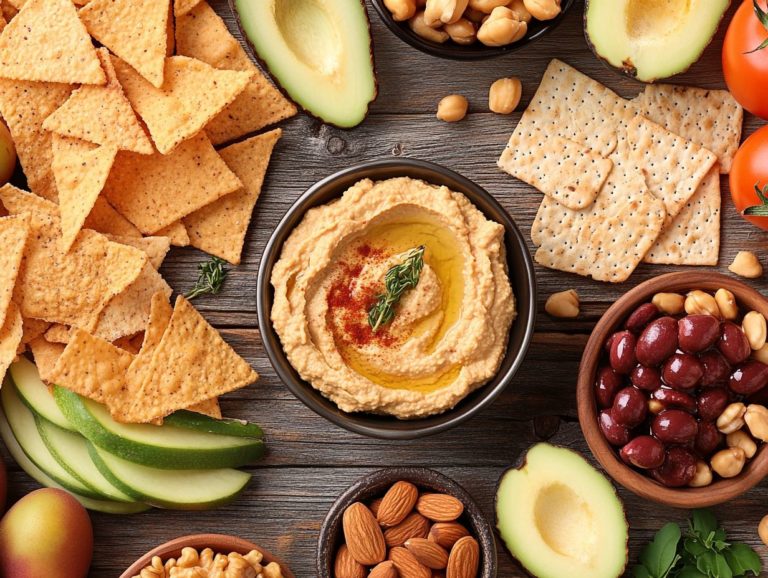What Are the Most Common Gluten-Free Flours?
In recent years, gluten-free diets have surged in popularity, prompting you to explore alternatives to traditional wheat flour. But what exactly is gluten, and why are so many opting for gluten-free options, including those from ancient civilizations like the Inca, Maya, and Aztec?
This article will guide you through the world of gluten and gluten-free flour, illuminating the benefits of making the switch. You ll find a closer look at some of the most common gluten-free flours available, from almond to tapioca, including sorghum and millet. These will help you understand how to seamlessly incorporate these versatile ingredients into your cooking and baking.
Dive in and discover the delicious possibilities that await you on your gluten-free journey!
Contents
Key Takeaways:
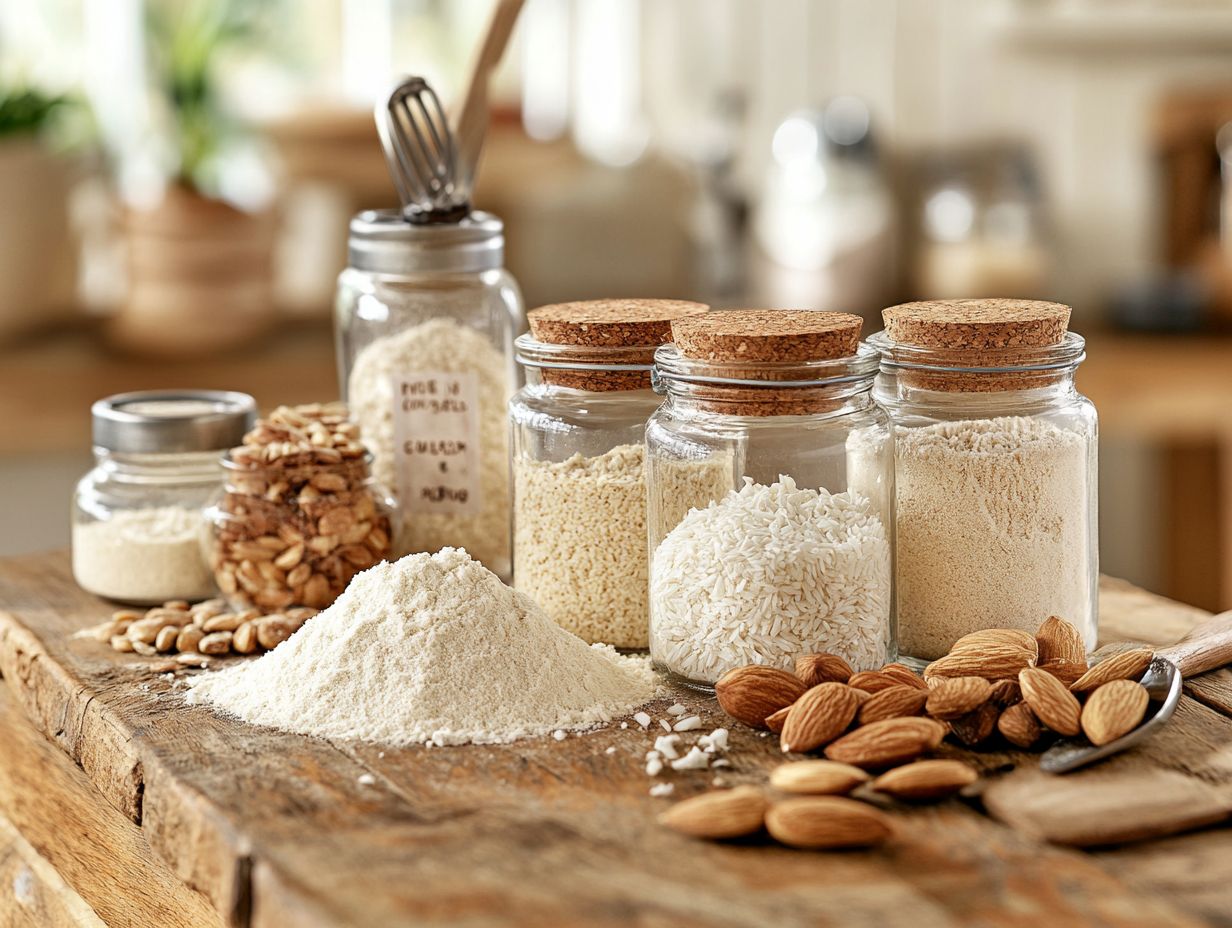
- Almond, coconut, and rice flour are commonly used gluten-free options.
- Chickpea, quinoa, and teff flour are rich in protein and fiber.
- Cassava and tapioca flour work well as thickeners in dishes.
What is Gluten?
Gluten is a group of proteins primarily found in wheat, barley, and rye. It is responsible for giving dough its delightful elasticity and aiding in its rise during baking.
This “glue” holds many baking recipes together, but it can pose significant health risks for a substantial portion of the population. Gluten sensitivity can manifest through various symptoms, including uncomfortable bloating and fatigue.
More severe reactions can occur in individuals with celiac disease, where the immune system reacts negatively to gluten. This reaction damages the intestinal lining and affects nutrient absorption.
As awareness of gluten-related disorders rises, the demand for gluten-free options is increasing. This highlights the need for alternatives that not only exclude gluten but also offer essential nutrients, including vitamins, minerals, and antioxidants.
By exploring a diverse array of gluten alternatives like quinoa, rice, millet, and other gluten-free grains, you can maintain a nourishing diet without compromising your health.
What is Gluten-Free Flour?
Gluten-free flour includes a range of premium flour alternatives crafted from grains, nuts, legumes, and other gluten-free sources. These flours are ideal for those with gluten sensitivity or celiac disease.
This selection features almond flour, coconut flour, sorghum flour, and buckwheat flour, each bringing distinct flavors, textures, and nutritional advantages. They often boast higher levels of vitamins, minerals, and fiber that benefit gut health compared to conventional wheat flour.
By incorporating gluten-free flour into your baking repertoire, you can relish delightful and wholesome dishes without sacrificing your health.
What Are the Benefits of Using Gluten-Free Flour?
If you have gluten sensitivity or celiac disease, switching to gluten-free flour can transform the way you enjoy food! Using gluten-free flour brings a wealth of health benefits, allowing you to enjoy a diverse range of foods without the worry of adverse health effects.
Many gluten-free flours are nutrient-dense, offering a rich composition of essential vitamins, minerals, and antioxidants. For instance, almond and coconut flour not only add a delightful flavor but are also higher in protein and healthy fats.
Some varieties contain resistant starch, a type of fiber that our bodies digest slowly, which helps maintain steady energy levels. Resistant starch supports digestive health and can elevate the texture and taste of your baked creations.
By incorporating flours like chickpea, oat, and brown rice into your culinary repertoire, you can further diversify your diet. These options not only enhance fiber content but also impart unique flavors to your baked goods.
They contribute to a lower glycemic index, making them an excellent choice for anyone looking to manage blood sugar levels. Resistant starch found in certain gluten-free flours, like green banana flour and oat flour, promotes beneficial gut bacteria and enhances feelings of fullness, potentially aiding in weight management.
By experimenting with various gluten-free flours, like millet and teff, you can achieve delightful results, crafting delicious treats that align perfectly with your health goals.
What Are the Most Common Gluten-Free Flours?
You ll find that the most common gluten-free flours include almond flour, coconut flour, chickpea flour, and buckwheat flour, each with its own unique flavors and textures that cater to your diverse culinary needs.
Almond flour, rich in healthy fats, protein, and vitamins, is a favorite among health enthusiasts like yourself. Coconut flour, on the other hand, brings a mild sweetness and boasts higher fiber content.
Chickpea flour and buckwheat flour are also fantastic options, celebrated for their versatility and nutrient density. With these options, you can create a wide array of gluten-free baked goods while enjoying the distinct nutritional benefits each flour offers.
1. Almond Flour
Almond flour stands out as a premium gluten-free flour crafted from finely ground almonds, celebrated not only for its rich flavor but also for its impressive health benefits. Almond flour is not only rich in protein and healthy fats but also packed with vitamins and antioxidants.
With its high protein and healthy fat content, it serves as an exceptional alternative to traditional wheat flour in a myriad of baking recipes. Imagine indulging in moist and flavorful creations like muffins, cookies, and breads, all while embracing a low-carb or ketogenic lifestyle.
The high vitamin E content and powerful antioxidants found in almond flour contribute to your overall health, making it a nutritious addition to your diet. Its slightly sweet and nutty flavor elevates the taste of pancakes, bread, and even pizza crusts, adding a delightful twist to classic recipes.
Consider using almond flour in chocolate chip cookies; it produces a tender texture that many find utterly irresistible. For those with gluten sensitivities, almond flour is a perfect choice, effortlessly broadening your baking repertoire without sacrificing taste or texture.
If you re on the hunt for healthy alternatives, almond flour will prove to be an invaluable ingredient in your culinary explorations.
2. Coconut Flour
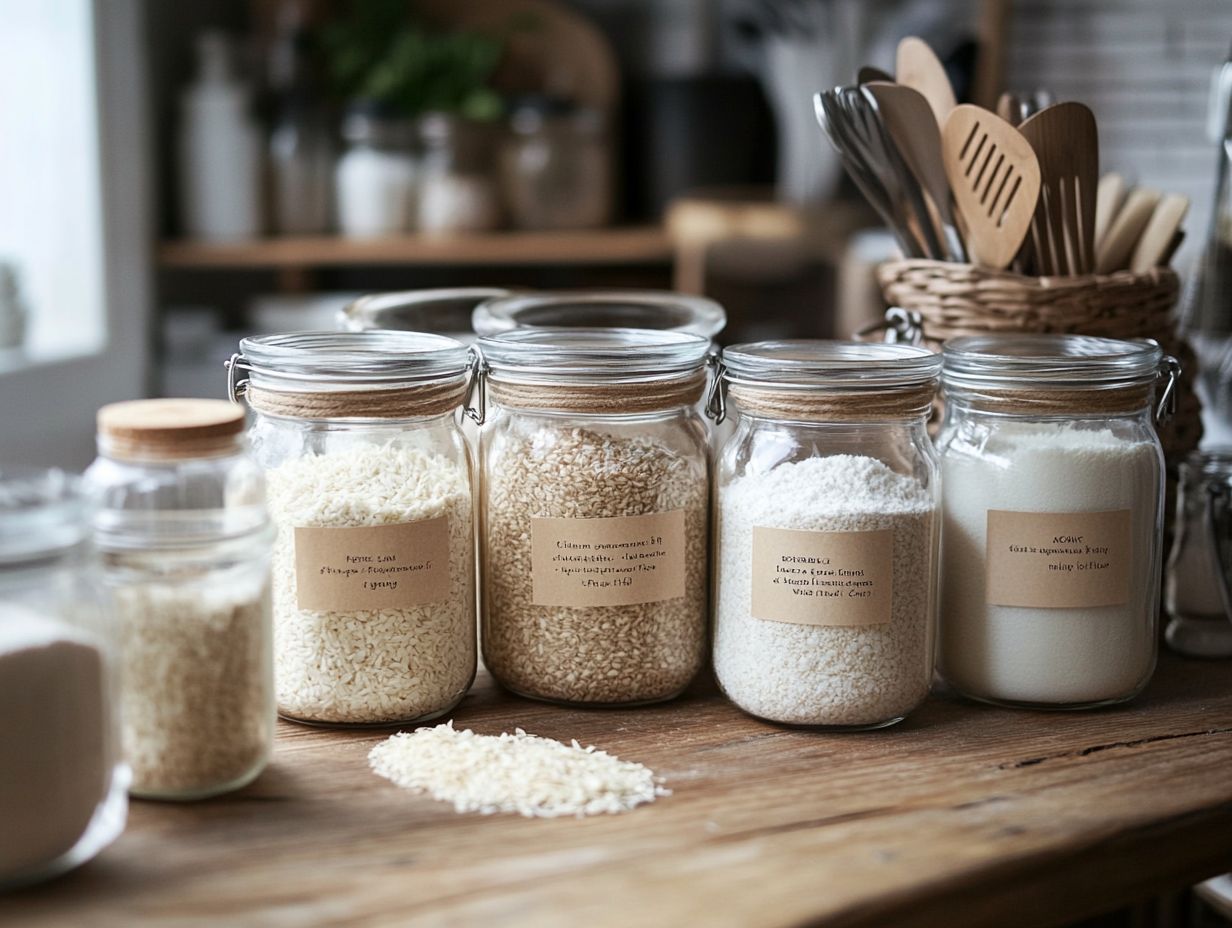
Coconut flour is a luxurious, gluten-free flour crafted from dried coconut meat. It is high in fiber, vitamins, and minerals, and has a delightful texture that adds a subtle sweetness to your baked creations.
Its remarkable ability to absorb moisture means you’ll need to make some adjustments in your recipes. This flour is a superb choice if you re looking for healthier, low-carb alternatives in your baking repertoire! It pairs beautifully with other gluten-free flours, enhancing both the flavor and nutritional profile of your favorite recipes, whether you re whipping up pancakes or cakes.
Coconut flour is a versatile ingredient, abundant in dietary fiber, which can support digestive health and leave you feeling satisfied. Since it can absorb up to four times its weight in liquid, you ll often need to either boost the hydration in your recipes or reduce the total amount of flour you use.
If you re venturing into the world of coconut flour for the first time, it s wise to start small. Try blending it with almond flour, oat flour, or brown rice flour to achieve the desired consistency.
Ideal for baking muffins, cookies, and bread, coconut flour also excels in savory dishes such as coconut-coated fish or cassava-based dishes. Its mild flavor harmonizes beautifully with a range of ingredients. Embrace the possibilities with coconut flour elevate your culinary creations today!
3. Rice Flour
Rice flour is your go-to gluten-free flour, crafted from finely ground rice. It offers a neutral flavor and a delicate texture, making it perfect for a range of baking endeavors. Its versatility allows you to whip up everything from fluffy pancakes to hearty bread and even silky sauces, establishing it as a cornerstone in any gluten-free kitchen.
You can enhance your creations by blending rice flour with other gluten-free flours, resulting in perfectly balanced textures and flavors in your baked goods.
Incorporating rice flour into your recipes can truly elevate your culinary repertoire, particularly if you re exploring gluten-free options. With its nutritional profile featuring carbohydrates, minimal fat, and essential vitamins, it stands out among other gluten-free alternatives like almond and coconut flour.
If you re feeling adventurous, rice flour can be effortlessly mixed into cookie batters, used as a thickening agent for soups and gravies, or even transformed into light, airy cakes. You can also blend it with teff flour for a unique, nutrient-rich twist.
For optimal results, consider pairing rice flour with xanthan gum, a binding agent that enhances dough elasticity, or psyllium husk to improve the binding qualities of your gluten-free baking.
4. Corn Flour
Corn flour is a gluten-free flour crafted from finely ground corn. It is celebrated for its subtly sweet flavor, vibrant yellow hue, and rich nutrient composition. This flour serves as a fantastic addition to a range of baked goods, infusing them with a distinct texture and moisture.
Whether you re whipping up cornbread, muffins, or pancakes, corn flour pairs beautifully with other gluten-free flours, allowing you to achieve the perfect results. Nutrient-rich and wholesome, it stands out as a smart choice for those embracing gluten-free options, especially for those with gluten sensitivity or celiac disease.
Not only does this flour enhance taste, but it also contributes a tender crumb and a slightly grainy texture that elevates the entire culinary experience. Beyond classics like cornbread and muffins, picture tortillas and cookies, where corn flour imparts its characteristic sweetness and a hint of corn essence.
Try incorporating brown rice flour or oat flour to further diversify your recipes. From a nutritional standpoint, corn flour offers fiber, essential vitamins, minerals, and antioxidants all of which support digestive health and boost energy levels.
Combine corn flour with almond or coconut flour, or even experiment with arrowroot flour or millet flour, to unlock the potential for innovative gluten-free treats that satisfy your cravings without sacrificing health. Its versatility truly makes corn flour an outstanding choice for any gluten-free baking adventure you embark on!
5. Chickpea Flour
Chickpea flour is a key ingredient in many traditional Inca, Maya, and Aztec recipes due to its rich nutrient composition.
Chickpea flour, often known as besan or gram flour, is a gluten-free gem made from ground chickpeas. It s celebrated for its high protein and fiber content while serving as a nutritious alternative to traditional flours. Its nutty flavor and dense texture make it perfect for savory baking think pancakes, fritters, or flatbreads. Boost your meals with chickpea flour for a delicious and healthy twist!
Chickpea flour also enhances sweet treats like brownies and cookies, replacing regular flour without sacrificing texture. If you want to add chickpea flour to your culinary toolkit, the possibilities are endless. Toss it into smoothies for a protein kick, use it to thicken soups and sauces, or mix it into batters for frying. Combining chickpea flour with teff flour also adds nutrition and flavor.
Dive into chickpea flour today and transform your meals into exciting culinary delights! Experimenting with this ingredient can turn your everyday dishes into health-conscious options that tantalize your taste buds while meeting dietary needs.
6. Buckwheat Flour
Buckwheat flour, a gluten-free gem made from ground buckwheat a healthy seed is your go-to choice for a healthy lifestyle, especially if you re gluten-sensitive or have celiac disease. It s packed with antioxidants, fiber, and essential amino acids, adding a wholesome touch to your cooking. The unique earthy flavor of buckwheat flour elevates a variety of baked goods, from pancakes to bread and cookies, while providing a delightful texture.
Incorporating buckwheat flour into your recipes not only enhances their nutritional profile but also adds a beautiful depth that s hard to resist. Thanks to its impressive properties, buckwheat flour helps protect your body from damage, giving your immune system a solid boost. Its rich amino acid profile supports muscle repair and growth, making it ideal for your active lifestyle.
For a delightful breakfast, consider whipping up some:
- Buckwheat pancakes topped with fresh fruits and a drizzle of maple syrup
- Savory buckwheat bread infused with fragrant herbs
And don’t forget the almond and buckwheat cookies; they re a scrumptious treat that showcases the flour’s rustic flavor, securing its place as a versatile staple in your kitchen.
7. Quinoa Flour
Quinoa flour is a gluten-free gem that you can easily add to your baking repertoire. Made from finely ground quinoa, it boasts a delightful nutty flavor and an impressive protein content, making it a nutritious choice for your culinary creations. This flour not only enhances the taste of your bread, cookies, and pancakes but also provides a wealth of vitamins and minerals. Its versatility allows you to blend it with other gluten-free flours like sorghum or teff, enhancing both flavor and texture.
By incorporating quinoa flour into your recipes, you significantly boost their health benefits without sacrificing taste. For example, using it in gluten-free brownies increases protein while still delivering that rich, fudgy indulgence you crave.
When you make pizza crust with quinoa flour, you ll enjoy not just the added nutrition but also a delightful crunch that brings healthy alternatives to the forefront. In muffins, this flour adds a moist texture and essential nutrients, ensuring your treats are both satisfying and wholesome.
Integrating quinoa flour into your meals can turn everyday recipes into powerhouse dishes packed with nourishing goodness, allowing you to enjoy delicious food while prioritizing your health.
8. Sorghum Flour
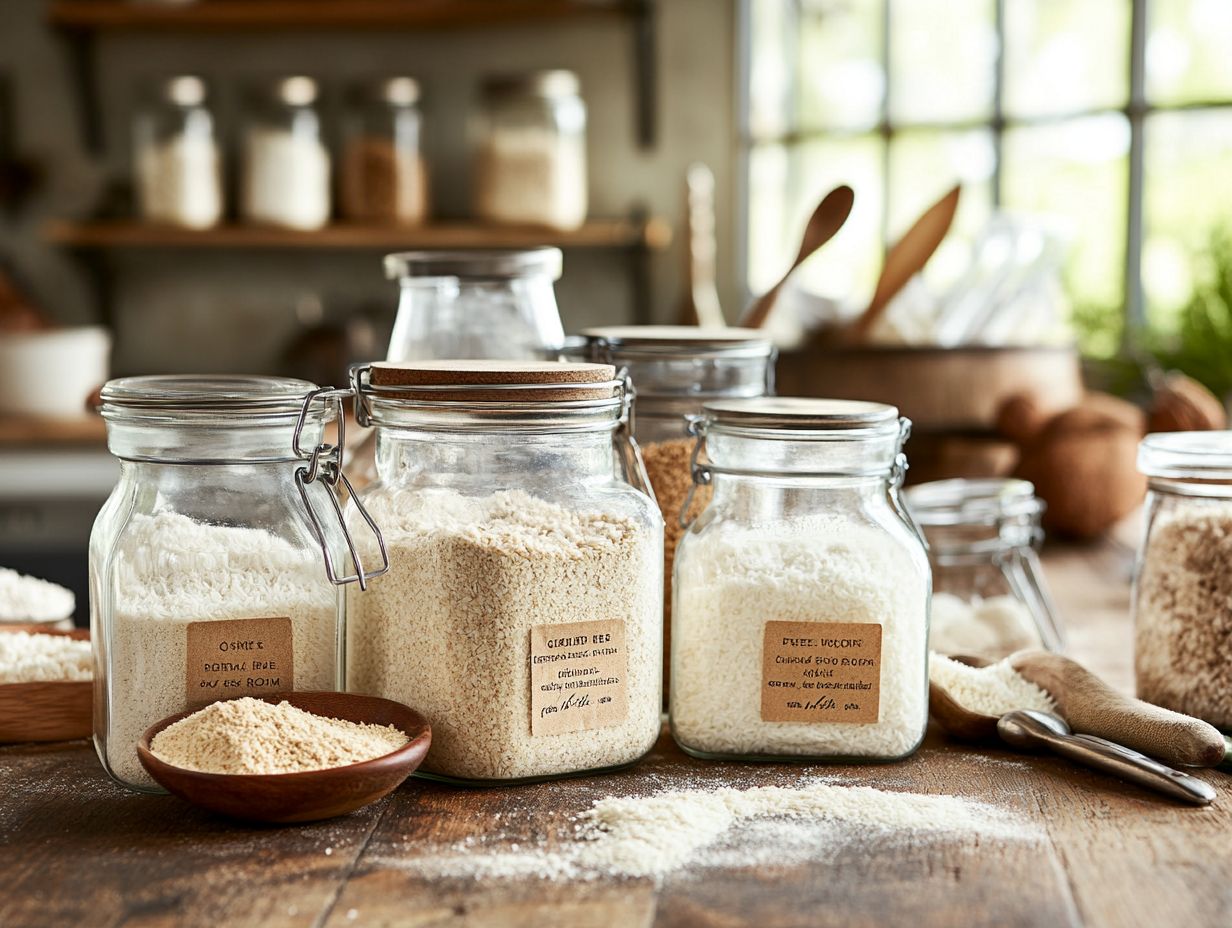
Sorghum flour has been a staple in the diets of the Inca, Maya, and Aztec civilizations, celebrated for its remarkable nutrient composition.
Sorghum flour is a gluten-free gem crafted from ground sorghum grain. It boasts a mild flavor and an impressive fiber content. This makes it an excellent choice for gluten-sensitive baking. Its light texture is perfect for whipping up a variety of baked goods, from fluffy pancakes to moist muffins and hearty bread. It provides essential nutrients to your diet. You can seamlessly blend sorghum flour with other gluten-free flours like almond flour or coconut flour to achieve a delightful balance of taste and texture in your recipes.
This nutrient-rich flour shines with its high dietary fiber content, which supports digestive health and keeps you feeling full. It’s a wise addition to any meal plan.
If you’re inclined to get creative, sorghum flour is fantastic in gluten-free baking recipes. It allows you to craft everything from robust bread loaves to flavorful pizza crusts and irresistible cookies.
Incorporating it into smoothies or energy bars can elevate your fiber intake. Combining it with almond or coconut flour enhances the texture and flavor of your baked creations. This ensures every bite is as nutritious as it is delicious.
So go ahead and explore the world of gluten-free baking with sorghum flour!
9. Millet Flour
Millet flour was highly valued by the Inca, Maya, and Aztec civilizations for its rich nutrient composition and versatility.
Millet flour is a marvelous gluten-free option made from ground millet seeds. It offers a mild, slightly sweet flavor along with a rich nutrient profile, making it an excellent choice for those who are gluten-sensitive or have celiac disease. Its high fiber content supports overall health. Essential minerals like magnesium and phosphorus enhance the texture of baked goods like bread, pancakes, and cookies. You might find that combining millet flour with other gluten-free flours like buckwheat flour or arrowroot flour can optimize both taste and nutritional value.
The unique flavor profile of millet flour brings a subtle sweetness to your recipes. It pairs beautifully with spices and other ingredients. For example, consider incorporating millet flour into savory dishes like flatbreads or using it to thicken soups and stews. If you have a sweet tooth, baking millet flour into muffins or energy bars can provide a nutritious snack that satisfies.
Its versatility invites exciting experimentation in the kitchen. This encourages you to explore its potential in both traditional dishes and innovative recipes.
Embrace millet flour and discover delicious gluten-free possibilities!
10. Cassava Flour
Cassava flour has been utilized by the Maya and Aztec civilizations for its remarkable versatility and nutrient composition.
Cassava flour, sourced from the cassava root, stands out as a gluten-free flour celebrated for its subtle flavor and remarkable versatility in gluten-free baking. This makes it a fantastic substitute for wheat flour. Rich in carbohydrates and a type of carbohydrate that supports gut health, it can also aid your digestive health. Its fine texture allows for easy incorporation into a variety of recipes, whether you’re making bread, tortillas, or pastries. It delivers a soft and chewy texture that echoes the charm of traditional baked goods. The nutrient composition of cassava flour makes it an excellent option for healthy alternatives in your diet.
Loaded with resistant starch, this exceptional flour provides many benefits, including improved gut health and enhanced satiety. This aids you in weight management. Whether you’re whipping up pancakes for breakfast, crafting a savory flatbread, or baking a sumptuous cake, cassava flour is a perfect choice.
For the best results, mix it with other gluten-free flours to create deliciously unique textures! Adjusting moisture levels in your recipes will further enhance the performance of cassava flour.
So dive into the delightful world of gluten-free baking with cassava flour!
Tapioca Flour
Tapioca flour, often referred to as tapioca starch, is a remarkable gluten-free flour derived from the cassava root. It s celebrated not just for its high starch content but also for its ability to impart delightful chewiness to baked goods. You ll love how tapioca flour transforms your dishes! This versatile flour serves as a thickening agent in sauces and soups or as a binding ingredient in gluten-free recipes, enhancing the overall texture and moisture of cakes and breads. Its neutral flavor makes it adaptable across a wide array of dishes. People in Inca, Maya, and Aztec cultures have used this flour in their traditional recipes.
Whether you re whipping up a savory stew or baking scrumptious cakes, tapioca flour truly shines in recipes like pancakes, cookies, and even pizza crusts. Its unique properties enable it to stabilize ingredients while providing that wonderful chewiness we all love in baked treats. If you re following a gluten-free diet, incorporating this flour into your cooking can help you achieve the textures that are often missing in traditional recipes. It also serves as an excellent resistant starch, which helps improve digestive health.
From thickening pie fillings to crafting vegan cheese sauces, tapioca flour has become an essential ingredient in modern gluten-free and health-conscious kitchens.
Potato Flour
Potato flour is your go-to gluten-free flour crafted from finely ground potatoes. It’s celebrated for its remarkable ability to retain moisture and elevate the texture of your baked creations. You can seamlessly incorporate this flour into a variety of recipes, from breads to cakes, where it provides a soft and tender crumb while imparting a unique flavor. It s particularly beneficial for those with celiac disease or gluten sensitivity.
Thanks to its high starch content, including resistant starch, it excels as a thickening agent in soups and sauces, making it an invaluable ally in gluten-free cooking.
But there’s more to potato flour than meets the eye; its distinct qualities truly shine in diverse culinary applications. When you add it to pancake or waffle batter, it results in a delightfully fluffy and moist texture that eagerly absorbs syrup. You can also mix it with other gluten-free flours like almond flour or teff flour for an enhanced texture.
In gluten-free bread recipes, it can enhance elasticity and rise, delivering that coveted bakery-quality texture that s often elusive with other gluten-free flours. It can also make your mashed potatoes creamier or act as a binding agent in veggie burgers, showcasing its remarkable versatility. For a nutrient boost, consider incorporating other flours like oat flour or sorghum flour into your baking recipes.
For those venturing into gluten-free territory, potato flour not only enriches flavors but also transforms traditional recipes into satisfying alternatives that everyone can enjoy. Its nutrient composition includes essential vitamins and minerals, making it a healthy alternative in cooking.
Frequently Asked Questions
What Are the Most Common Gluten-Free Flours?
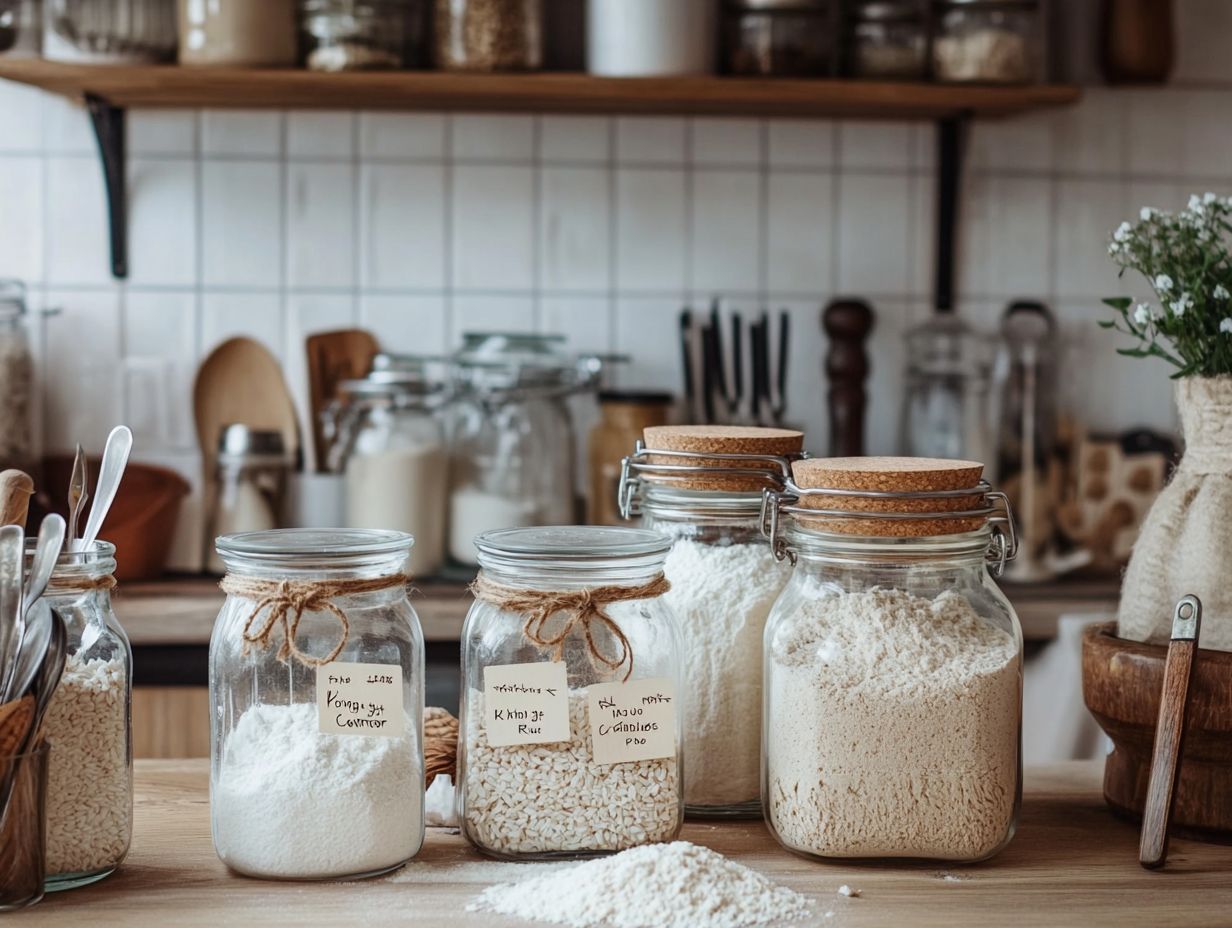
The most common gluten-free flours are almond flour, coconut flour, rice flour, tapioca flour, corn flour, buckwheat flour, chickpea flour, oat flour, millet flour, cassava flour, sorghum flour, teff flour, and arrowroot flour.
What is Almond Flour?
Almond flour is a gluten-free flour made from finely ground almonds. It has a slightly nutty flavor and is often used in baked goods as a substitute for wheat flour. It s rich in nutrients, including antioxidants, and is great for maintaining a balanced diet.
What is Coconut Flour?
Coconut flour is made from dried and ground coconut meat. It is high in fiber, low in carbohydrates, and is often used in gluten-free baking. It s a popular choice in Inca, Maya, and Aztec cuisines.
What is Rice Flour?
Rice flour is a gluten-free flour made from ground rice grains. It can be made from either white or brown rice and is often used in Asian cuisine. Brown rice flour is especially noted for its high nutrient content.
Alternative Gluten-Free Flours
What is Tapioca Flour?
Tapioca flour, also known as tapioca starch, is a gluten-free flour made from the cassava root. People often use it to thicken soups, sauces, and puddings. It’s a staple in many healthy alternatives for gluten-containing recipes.
What is Corn Flour?
Corn flour is a gluten-free flour made from finely ground cornmeal. It’s commonly used in baking and as a thickening agent in sauces and soups. This flour works well with other flours for various cooking needs.
What is Buckwheat Flour?
Buckwheat flour is made from ground buckwheat groats and is naturally gluten-free. It has a slightly nutty flavor, making it ideal for pancakes, crepes, and breads. Mixing it with chickpea flour or cassava flour enhances both nutrition and texture.
Try these fantastic gluten-free flours and elevate your cooking today!

